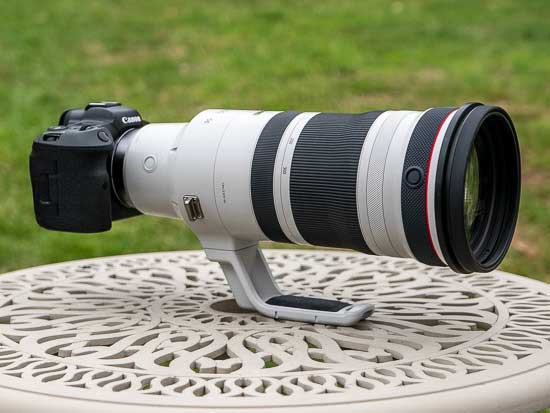
Introduction
The Canon RF 100-300mm F2.8L IS USM is a professional telephoto zoom lens for Canon’s extensive range of full-frame mirrorless cameras.
Taking the popular EF 300mm f/2.8 prime lens as their starting point, Canon have designed the new RF 100-300mm f/2.8 to offer the same levels of sharpness and image quality whilst offering the versatility of a zoom for more easily tracking moving subjects.
Optically, the lens design is comprised of 23 elements in 18 groups, including one Fluorite, four UD and one GMo aspherical elements to help achieve a higher degree of clarity and sharpness with virtually no distortion.
Air Sphere Coating (ASC) and Super Spectra Coatings (SSC) have been applied to the lens elements to help reduce backlit flaring and ghosting
As this is an L series lens, Canon says it also boasts the highest possible build quality, which includes weather-sealing and fluorine coatings on both the front and rear elements to guard against water droplets and dust. Canon’s special white heat shield coating ensures consistent operation in high temperatures.
An Optical Image Stabilizer helps to minimize the appearance of camera shake by 5.5 stops, with three different IS modes on offer.
The lens has a configurable Control Ring which can be used to adjust a variety of exposure settings, including aperture, ISO, and exposure compensation.
It also features a Dual Nano USM auto-focusing system incorporating both a ring type USM and an STM mechanism, fast, nearly silent autofocusing with full-time manual focus override, a 9-blade aperture for more attractive out of focus areas, and a rotating tripod collar.
The Canon RF 100-300mm F2.8L IS USM lens is available from May 2023 priced at £11,499 / €11,999 / $9,499 in the UK, Europe and the US, respectively. It is made in Japan.
The reach of the RF 100-300mm F2.8L IS USM can be increased up to 200-600mm f/5.6 with the RF 2x extender, or 140-420mm f/4 with the RF 1.4x extender, with no sacrifice in focus speed or durability and across the entire zoom range.
Ease of Use

Weighing in at a whopping 2,590g / 91.4oz and measuring 32.3cm in length, this is not a lens for the faint-hearted! Note that it uses an internal zoom design and therefore does not extend as you zoom from 100mm to 300mm or vice-versa.
We’ve been testing it with the Canon EOS R5, a camera body that it is very likely to be paired with by the professional users who are drawn to this lens in the first place. You’d achieve an even better balance by attaching the optional battery grip for the Canon EOS R5, too.

As you’d expect, the lens feels incredibly well built, with the weatherproofing giving you confidence that you can shoot using this lens in all kinds of different conditions. The lens mount is a high-quality metal construction, which again feels very strong and secure.
In order to attach the lens to the camera, you’ll see that there is a red line on the rear of the lens, which matches up to a similar red line on the camera body itself. Line the two up, and twist to lock the lens into place.

Around the Canon RF 100-300mm F2.8L IS USM lens there are three different rings to take note of.
In the middle of the lens you’ll find the largest ring, which controls the zoom of the lens. It is dark grey in colour and marked with four different focal lengths to help you quickly jump to the focal length you want – 100, 135, 300mm and 300mm.
The zoom ring is ridged to help you get a good grip on it, and like the rest of the lens feels very sturdy and high-quality. It is quite audible in operation, though, emitting a distinctly metallic sound as you turn it – maybe this will lessen with time and use.

Towards the rear of the lens barrel you’ll find the manual focusing ring ring which is about a quarter of the size of the zoom ring. It is similarly coloured and ridged to the zoom ring, but feels slightly different – if you’re not looking at the lens, you should be able to feel the difference in textures quite easily.
The focusing ring has just enough give to it to make fine tuning manual focus nicely precise, without being too tight or too loose.

Towards the front of the lens barrel there’s a slim white, knurled ring which you can use to quickly access different settings which you can customise from the camera body. Depending on what you want to do, you can use it to change aperture, shutter speed, ISO or exposure compensation. You can also turn it off.
This ring has another different texture to the other two rings so again you can find it easily without looking at the lens. It’s worth noting that this lens clicks as you rotate it – that’s helpful for hearing or monitoring as you change a setting, but is less useful if you’re shooting video rather than stills.

At the very front of the Canon RF 100-300mm F2.8L IS USM lens, you’ll see the distinctive red ring which adorns all Canon L series “professional” lenses. It doesn’t do anything, but it marks out the lens as belonging to the high-end range.
On the left-hand side of the lens, looking from the rear, are five switches. Starting from the top we find the Lens Function / Focus Preset / Selector switch.

The Focus Preset option allows you to preset any focusing distance and then instantly focus at that point even when you’re shooting a different subject. This operates in both AF and MF modes. The Recall option then allows you shoot at the preset focusing distance.
Almost at the very front of the lens is a dark grey, knurled circle into which are set four Lens Function buttons which by default act as Focus Hold/AF Stop buttons. You can choose to assign different functions to these buttons from the Customize Buttons section of the camera’s menu system.
Underneath is a Focus Limiter switch with two settings, Full (1.8m to infinity) or 6m to Infinity.

Next is the standard AF/MF switch which sits just above an image stabiliser switch, which can be set to either on or off.
Auto-fcusing proved to be extremely quick, quiet and accurate for virtually all of the time. The hit rate when using it in conjunction with the EOS R5 camera was very high, making it ideal for capturing exactly the right moment during sports and action photography.
The autofocusing is also very quiet, making it ideal for discreet situations (such as wildlife photography), as well as for use while filming videos.

Focusing is internal, meaning the front element of the lens doesn’t move when focusing or zooming. You can therefore use it easily with filters, although the thread is a rather massive 112mm in size.
Underneath that is the Stabilizer Mode switch, which has three settings marked 1 / 2 / 3.
Mode 1 corrects vibrations in all directions and is best suited to still photographs. Mode 2 is for panning shots taken either horizontally or vertically and is best suited to moving subjects. Mode 3 corrects vibrations in the same way as Mode 2 but only during the exposure, making it best suited to irregularly moving subjects

Around the base of the lens is a moveable but non-removable tripod collar/foot. This is not only useful when using the lens with a tripod, but also when handholding the lens to keep it as steady as possible.
You can move the foot around the lens to whichever position you need, giving you good flexibility to move your camera. The mount clicks at 4 positions, every 90 degrees.

There is a security slot located under the cover of the orientation locking knob which allows you to attach a wire-type security lock.
Two metal lugs are attached which are used for attaching the supplied shoulder strap, a rather essential accessory given the weight of thsi lens.

A high-quality lens hood (ET-124) is included in the box which is attached to the lens by sliding it on and then using the knurled hood lock knob to tighten it into place. The hood can be reverse mounted on the lens for easier storage.
There’s also a good quality padded case (LS100-300) as well as front and rear lens caps provided in the box.





Focal Range
At the 100mm focal length the angle of view is 24° degrees.

100mm
At the 300mm focal length the angle of view is 8° degrees 15′.

300mm
Chromatic Aberrations
Usually seen as purple or blue fringes along high-contrast edged in a photograph, chromatic aberration can be a problem for some lenses. With the Canon RF 100-300mm F2.8L IS USM lens however it is extremely well-controlled, to the extent that it’s very difficult to find examples of any kind of fringing occurring at all. An extremely impressive performance.

100mm

300mm
Vignetting
When shooting at the maximum aperture of f/2.8, you can see some light vignetting at 100mm. It’s not hugely noticeable when shooting normal subjects, but you can see it when photographing a white wall. The effect is much more minimal when shooting at 300mm. Throughout the focal lengths, the problem almost completely disappears when you close down the aperture to f/5.6.

100mm / JPEG

100mm / RAW

300mm / JPEG

300mm / RAW
Distortion
There’s some barrel distortion evident at 100mm and quite a lot of pin-cushion distortion at 300mm in the RAW files – the Canon EOS R5 camera automatically and successfully applies corrections to the JPEG files that removes most of it.

100mm / JPEG

100mm / RAW

300mm / JPEG

300mm / RAW
Macro
The Canon RF 100-300mm F2.8L IS USM is not a designated macro lens, but you might want to engage it for typical macro subjects, such as flowers, especially at the telephoto end of the lens.
The closest focusing distance is 1.8m at either end of the lens, and the maximum magnification available is 0.16x at the 300mm focal length (0.06x at 100mm).




Bokeh
Bokeh is a word used for the out-of-focus areas of a photograph, and is usually described in qualitative terms, such as smooth / creamy / harsh etc.
With a wide maximum constant aperture of f/2.8, 9 aperture blades and a high-quality construction, we’d expect the Canon RF 100-300mm F2.8L IS USM to produce great bokeh, and we have not been disappointed.
We do realise, however, that bokeh evaluation is subjective, so we’ve included several examples below for your perusal.








Sharpness
In order to show you how sharp the Canon RF 100-300mm F2.8L IS USM lens is, we are providing 100% crops on the following pages.
Credit : Source Post



